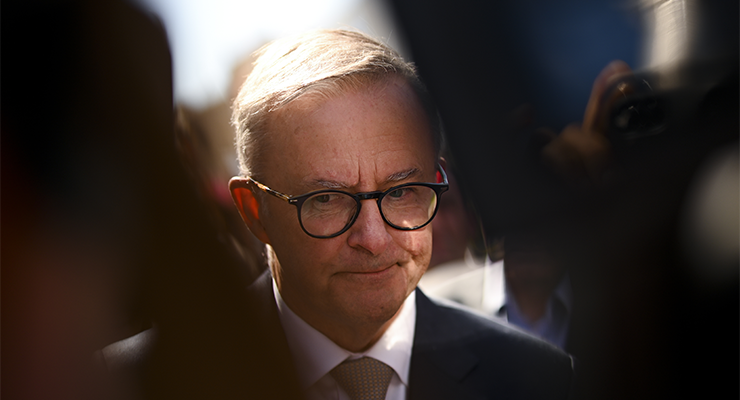
This article first appeared in InQueensland.
When Scott Morrison fronts the media, it is as planned, scripted and risk-assessed as everything else the Liberal leader does. He has, in his famously self-identified “flow-brain” (a pop psychology term for total immersion in an activity), the data and word pictures needed to sell the day’s offering.
Morrison also has in front of him a shuffle of papers with double-spaced notes on everything his campaign team thinks might be raised by journalists looking for an angle or finding some soft flesh to puncture.
He uses those notes, juggling papers and reading from them word for word.
It’s a sensible approach, reducing risk and minimising the opportunities for the media to find a gap, a hole or a contradiction.
Most of the time it works, helped by Morrison’s formidable ability to bluster with word salad that often collapses into gibberish.
It’s all done with such self-belief and confected conviction, even the nastiest gotcha lazy journalist is left without a line of sight on what actually happened.
Morrison shouldn’t be allowed to get away with it but he has been given the benefit of the doubt since the pandemic kicked off two years and two months ago. All of this was a construct, like everything else this 24/7 political being does.
Learning from the way John Curtin handled the media during World War II, Morrison brought the leaders of the press gallery into the sanctum — they were given the deepest “off the record” background briefings with Health and Treasury officials. The briefings were very regular at first, sometimes more than once a week.
Through this relationship — which Curtin used to make sure the national media didn’t threaten the security of the war effort — Morrison protected his own personal and political security. It wasn’t about protecting the health and economic safety of the nation but had a sole aim of controlling and owning the daily narrative to the single advantage of the most political and ambitiously driven prime minister the country’s ever seen.
At the same time, Morrison entrenched a polling program that never stopped. The Liberal Party kept testing opinion, assisted by publicly-funded surveys tracking attitudes to various programs and trends.
This is the never-ending campaign machine Morrison carries around with him, in his head and in those pages on his lecterns. It is the complete melding of the campaign director (Morrison ran the Liberal’s New South Wales branch for more than half a decade).
The data might change but the mission never wavers — searching for the binary choice, dividing and conquering and to the winner the spoils, all of the spoils.
The Morrison playbook is called “genius campaigning” by some but it’s actually a very narrow set of skills. A close look at how Morrison moves, behaves and speaks in this campaign, and lining it up against what he did in 2019, shows there is not much difference, which is its purported brilliance and also its potential weakness.
This background provides insight into the way Anthony Albanese is handling himself during this campaign and how it’s being presented in the media.
Albanese has had genuine stumbles — not knowing the then official Reserve Bank cash rate and the unemployment rate were real, inexcusable foot-in-mouth moments — and he’s been awkward and unprepared in a few responses.
The inability to get through what should have been a simple question on Thursday — the six priorities of his own national disability insurance scheme plan — was also inexcusable and can only be attributed to poor preparation and a confidence in “winging it”, seen by colleagues as a weakness in the way Albanese handles things.
Albanese can be excused for not knowing the fine details of everything but there’s no excuse for not knowing enough to get through a question in a campaign media conference.
The Labor leader should have had enough of the basic detail in his mind to answer at least half of the question and then have enough rhetorical flourish at hand to get through the rest. It’s what Morrison does.
John Howard came out of his bruising time in the late 1980s convinced the way to beat Labor was to “get up earlier and go to bed later” than Labor, ringing all of the radio stations before breakfast and checking in with all of the newspapers before bedtime.
It was his operating system in the lead up to the 1996 election and he made sure the mistakes he made in the 1985/88 period were not repeated. A landslide was his reward.
This is how Labor and Albanese will need to approach the last two weeks if they want to secure victory.
Also, he should wean himself off the props of having shadow ministers as backstops. It has not served him well in the bigger scheme of things and recalls the 1980 election campaign when Labor had Bill Hayden travel the country with ALP president (and NSW rockstar) Neville Wran and ACTU president Bob Hawke backing him up. The comparison and contrast didn’t help at the end of a losing bid for power.
At the moment Albanese is metaphorically similar to the big theme behind Tennessee Williams’s Cat on a Hot Tin Roof, a world running out of lives.








I do not understand why a Managing Director with a Talented Team of Managers is not the preferred management model for the Prime Minister and his group of Ministers in Cabinet.
The current development over recent decades of a Presidential style Prime Minister with the ‘gift of the gab’, and a ‘grab bag’ group of hidden ministers, does not inform the voters about the degree of talent a Cabinet needs to have to govern the country.
Journalists do us no service if they continue to be cheerleaders for an entertainment event instead of gathering and offering intelligent analysis and factual information that help people understand what is needed to run a country and what is actually being offered and/or delivered by those wanting our vote.
I prefer Albo’s approach that is including his Shadow Ministers with him at Press Conferences. I think Albo should showcase his team.
We all have ‘brain farts’ and it only means information that is there is blocked for a second.
When a policy is based on principles, as Labor’s have been, Albo is best to go to the principles and if that does not trigger the detail then he should pass the answering onto someone who he has now given time to formulate an answer.
There are people with good exam technique who make terrible practitioners of their profession in the real world.
Gotcha questions or the answers they elicit tell us nothing.
Probably a good analysis Denis but I wouldn’t know and I suspect it doesn’t matter very much. Most people don’t give a tinkers cuss what Morrison does, although I believe women are responding to a less combative, quieter team approach Albanese seems to be projecting. A majority of Australians south of the Tweed have seen through Morrison’s cosplay, stunts and announcements and stopped listening and started laughing at him some time ago. Maybe not in Queensland which doesn’t have much of a Voices or Indie movement where Susie Holt seems to be the only quality Indie but in a tough seat. Morrison is unelectable in most of Australia and his flaws are highlighted daily with help from thousands of Voices volunteers and some very talented Indies. The Libs and Nats fear a wipeout. Morgan, the only reliable independent public poll, has a 10.4% swing on in Victoria. Barrabas Loins has been in Shepparton 4 times in 3 weeks announcing his pants off after doing nothing for Nicholls for 8 years. The 2 coalition candidates are now collaborating trying to minimise preference leakage and ward off the Priestly push, which has more volunteers than the 2 coalition parties have members.
This is all going on outside the view of most of the media who are still obsessed with the Lib/Lab duopoly and what stupid thing a PHON, UAP or Nats candidate has done or whether Morrison is a campaigning genius. Tip: he’s not, he doesn’t listen (rule #1 in a democracy), he’s a pretender, people have woken up he’s a fraud who isn’t into delivery and he’s being destroyed by old fashioned doorknocking and modem digital media.
Albo could also learn from the great Labor leaders who preceded him, Gough Whitlam, Bob Hawke, Paul Keating and Julia Gillard. All had unshakable confidence in themselves and their policies. Albo has neither the self-confidence nor the policies but he could avoid the gotchas in the time-honoured way by simply ignoring the question and saying what he wants to say. Julia used to say, “The question you should be asking is this …” Joh Bjelke Petersen was another master of that type of response.
They all do it to some extent. On the other hand, it could detract from Albo’s reputation for sincerity.
Morrison has a script of fiction to adhere to, whereas Albo is trying to wing it with facts.
To do the latter requires knowing some,such as what day it is.
On the evidence so far, he might as well remain invisible – every time he appears in public it reminds voters what a dead loss he is and further erodes the already slim chance of being shot of Scummo.
Unfortunately, that tactic only works if you can remember the facts…
Also comes over as sincere. Morrison really doesn’t. He is just a salesman making the best he can out of a poor situation. I am not enamoured with either party but at least I trust Labour.
Do you think that he is still suffering from the virus? I do.
I feel that he was more affected than Scomo and went back to campaigning too soon. Even leaving it till the following Monday would have helped.His team were “on it” even if Marles also succumbed.